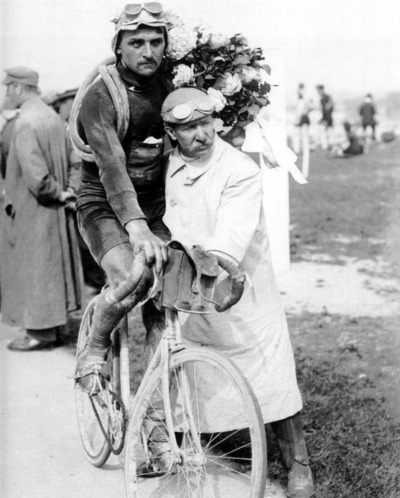Fixed Wheels and Simple Designs
It had been a tough morning. I’d been working on a dense slab of C code. The unit tests were in place: now I’d started to simplify, extracting cut and paste code blocks, unifying types, eliminating casts, stripping redundant comments, eliminating unreachable and commented-out code. It had become an uphill struggle and I needed a break.
I walked down Park Street, down past the fashionable cafes and restaurants, down past the trendy clothes shops, down past the art shops. Near the bottom of the hill an unusual bike in the window of Dave Bater cycles caught my eye.

The design of the road bicycle hasn’t changed much in the past hundred years. The bike used by François Faber, winner of the Tour de France in 1909, a 4500 km epic cursed with bad weather and reputed to be the toughest ever — Faber’s bike looks remarkably similar to the road bikes used today: the frame geometry, the pair of equal-sized spoked wheels, the drop handle-bars, the crank and chain transmission system — all much the same. Antoine de Saint-Euxpery famously described the point at which design perfection is achieved — “not when there is nothing left to add, but when there is nothing left to take away” — a quotation repeated too many times now, but all too true when it comes to human-powered ascent of Alpe d’Huez.

Yet the bike in the shop window on Park Street had found a way to simplify even this durable design. It had no gears, no drop to the handle bars, no toe clips. Certainly no mudguards, rack or bottle-cage — not even braze-ons for attaching such frivolities. Its minimal design had a certain appeal.
I’d seen bikes like this used before by cycle couriers in central London. For short journeys over flat terrain, they have some advantages. In fact, one further reduction is possible: if you dispense with the freewheel you don’t need brakes, and I have seen a courier riding a fixed wheel, though I suspect in his case turning heads was more important than turning pedals 1.
François Faber’s bike has no gears either. They’d been invented but Henri Desgrange, original director of the Tour de France, prohibited their use. He tried to ban freewheels too, but then his perfect Tour would have had a perfect winner only if just one man survived.
Good design is simple, not severe. Good code is concise, not minimal.
Many years ago I worked as a bicycle courier in Sydney, a city famous for its harbour and surrounding hills. My bike had 18 gears and I needed every one of them. Bristol too is reknowned for its hills. Park Street isn’t quite the steepest of these, but I wouldn’t fancy attempting it on the bike in the shop window.
I turned back up the hill towards work. Maybe a salad for lunch, and an afternoon tinkering with shell scripts.
1I’m reminded of a cycling school friend who used to cruise the mean streets of Ealing on a fixed-wheel bike. A girl at the side of the road caught his eye, he’d caught hers too, so he slowed down and made a neat U-turn to say hello. He’d forgotten he couldn’t freewheel. His legs stopped, the pedals didn’t, and his stubborn mount unsaddled him. He limped home alone.
Feedback
-
Cyclists use the same design of bike to win the Tour de France as they did in 1909 because the UCI says so. The UCI banned recumbent bikes from competitive cycling events.
Nice article. Nice bike.
-
Cyclists use the same design of bike to win the Tour de France as they did in 1909 because the UCI says so. The UCI banned recumbent bikes from competitive cycling events.
I guess recumbents are faster, but they're not better for road use, and certainly not for group finishes. How do they cope with hills?
My point is that the basic design of the road bike hasn't changed that much. I bought a new bike last year which really wasn't very different from a bike I might have bought 50 years ago, say.
Nice bike.
It is a nice looking bike -- well suited to somewhere flat!